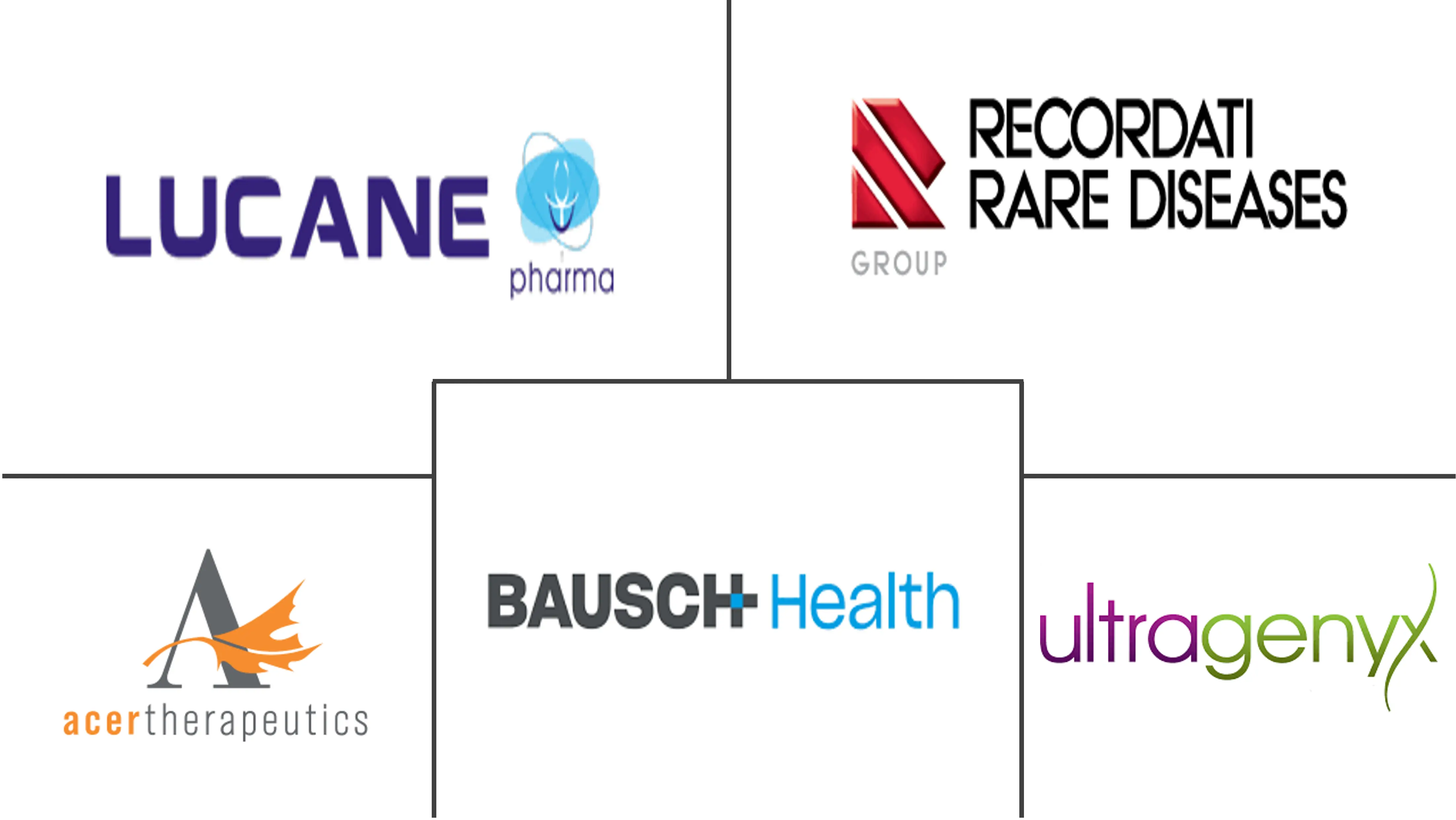Global Urea Cycle Disorder Market Size and Share
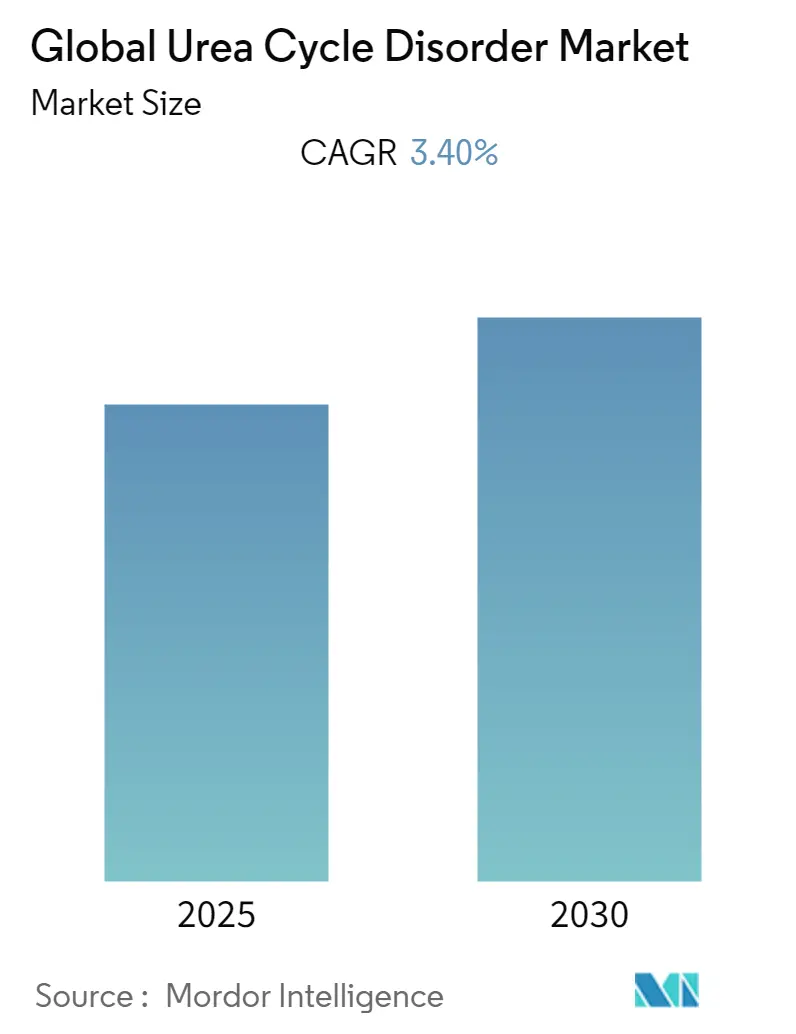
Global Urea Cycle Disorder Market Analysis by Mordor Intelligence
The Global Urea Cycle Disorder Market is expected to register a CAGR of 3.4% during the forecast period.
In recent times, countries have faced a huge threat of COVID-19. According to the World Health Organization (WHO), coronavirus is an infectious disease, and most people infected with the COVID-19 virus will experience mild to moderate respiratory illness.
The emergence of the COVID-19 pandemic harmed the world economy and the healthcare system. The article 'Longitudinal Metabolomics Reveals Ornithine Cycle Dysregulation Correlates With Inflammation and Coagulation in COVID-19 Severe Patients,' published in December 2021, identified that the ornithine cycle dysregulation is significantly correlated with inflammation and coagulation in severe patients, which may be a potential mechanism of COVID-19 pathogenicity. Therefore, the COVID-19 medications hampered the urea cycle, leading to a deficiency of certain enzymes. Hence, there is an increasing demand for its therapeutics, contributing to market growth.
However, the production of these drugs was hampered due to the temporary lockdown in the manufacturing plants, shortage of skilled labor, and increasing cases of COVID-19 inside the manufacturing plants, which has led to outages, thus, impacting the market. Hence, the above factors indicate that COVID-19 significantly impacted the studied market.
The factors propelling the studied market growth are the rising prevalence of urea cycle disorders and the increasing number of pipeline products. Product launches, approvals, and strategic initiatives by key market players are expected to contribute to significant market growth.
Hyperammonemia is a metabolic condition characterized by raised ammonia levels, a nitrogen-containing compound. Consequently, urea cycle disorders lead to an accumulation of ammonia. Ammonia is extremely toxic, particularly to the central nervous system. As per the article published in Statpearls in November 2021, the prevalence of ornithine transcarbamylase deficiency-led urea cycle disorder is estimated to be 1in 140,000 people. It is the most common type of urea cycle disorder. Although it is a rare disease, its prevalence, if found to increase, thereby effective therapeutics are demanded, thus, driving the market.
Additionally, research and development studies highlighting the genetic characterization of urea cycle disorders will help market players align their product development, contributing to market growth. For instance, the study titled 'Clinical and Genetic Characterization and Biochemical Correlation at Presentation in 48 Patients Diagnosed with Urea Cycle Disorders at the Hospital Juan P Garrahan, Argentina,' published in September 2021, demonstrated that patients with early onset of the disease suffer the most severe forms and still have high morbimortality. At the same time, patients with late-onset are less severe and finally diagnosed due to one or more acute episodes.
Moreover, strategic initiatives such as partnerships, expansions, and acquisitions will also lead to significant market growth. For instance, in October 2021, Boehringer Ingelheim and Thoeris GmbH announced a collaboration and license agreement to investigate novel first-in-class therapies for patients with urea cycle disorders (UCDs). Such partnership will help players leverage their expertise and expand their product offerings, thus propelling the market.
Therefore, owing to the factors mentioned above, the studied market is expected to grow significantly during the study period. However, the high cost of therapeutics is expected to hinder the market growth during the forecast period.
Global Urea Cycle Disorder Market Trends and Insights
Ornithine Transcarbamylas Segment is Expected to Account for the Largest Market Share During the Forecast Period
Ornithine transcarbamylase deficiency is a highly prevalent urea cycle disorder. It is an X-linked genetic disorder that prevents the breakdown and excretion of ammonia. It allows ammonia to accumulate, rising to toxic levels where it affects the central nervous system.
The factors such as product approvals, rising research and development, and strategic initiatives adopted by key market players are expected to contribute to the significant growth of the market.
For instance, in July 2021, Arcturus Therapeutics Holdings Inc. received approval from the UK Health Research Authority to initiate a Phase II clinical study for ARCT-810, a novel mRNA-based therapeutic candidate for Ornithine Transcarbamylase (OTC) Deficiency. Also, in April 2020, the company accepted two clinical trials for its flagship asset ARCT-810. The Company's Investigational New Drug (IND) application for a Phase Ib study in patients with OTC deficiency was allowed to proceed by the United States Food and Drug Administration (FDA), and an additional Clinical Trial Application (CTA) for a Phase I study in healthy volunteers was approved by the New Zealand Medicines and Medical Devices Safety Authority (Medsafe). Thus, with rising product approvals and research and development activities, the studied segment is expected to introduce effective therapeutics to boost the market's growth.
The study 'Effect of Ornithine Transcarbamylase (OTC) Deficiency on Pregnancy and Puerperium,' published in January 2022, highlighted that pregnancy, childbirth, and the postpartum period are considered challenging for women with this hereditary metabolic disorder, with a risk of hyperammonemia, especially in the first week after delivery. Therefore, a demand for the gradual increase of protein intake and other therapeutics indicates huge market potential.
According to the study 'Corticosteroid suppresses urea-cycle-related gene expressions in ornithine transcarbamylase deficiency,' published in March 2022, early intervention by renal replacement therapy in cases of UCD patients induced by corticosteroids to avoid brain injuries or fatal outcomes will increase the demand for OCT deficiency treatment, thus, driving the market.
Thus, due to the abovementioned factors, the studied segment is expected to contribute to the significant growth of the market.
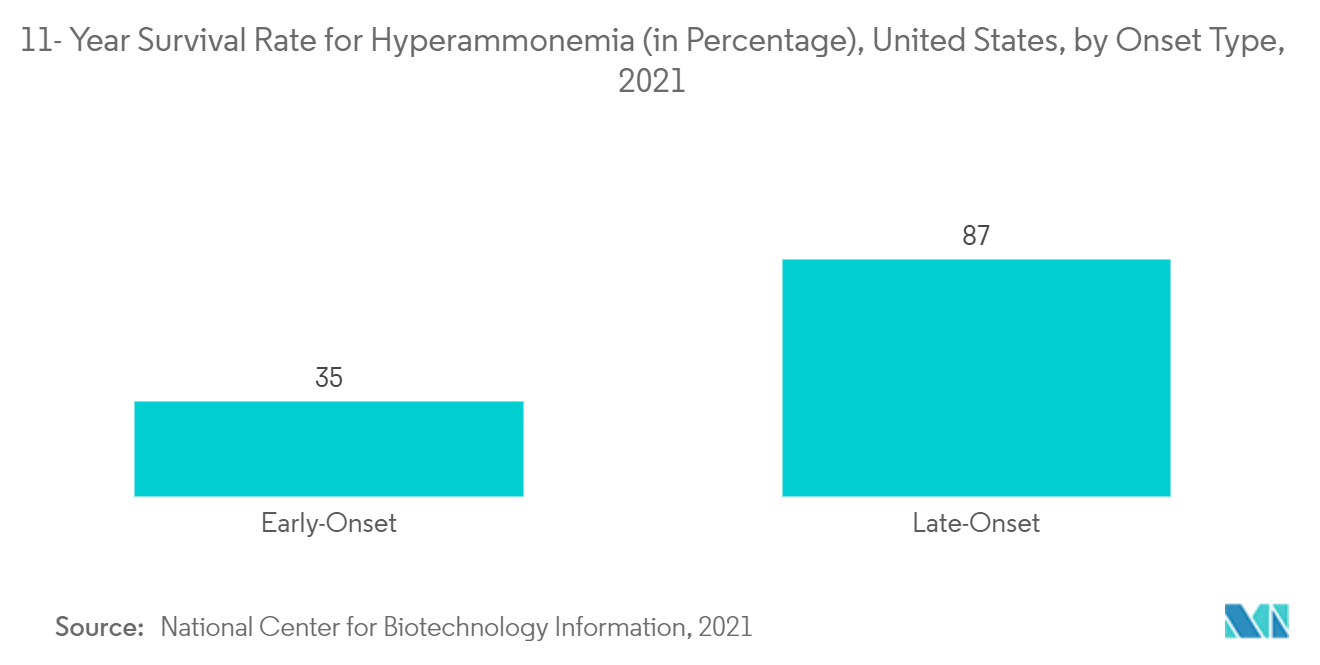
North America is Expected to Hold a Significant Share in the Market and Expected to do Same in the Forecast Period
The primary driving factors for the growth of the North American urea cycle disorder market are the rising prevalence of urea cycle disorders in the region and the increasing number of pipeline products. In addition, rising product launches and other strategic initiatives such as mergers and acquisitions and partnerships are also expected to drive the market's growth.
The United States within North America is expected to hold a significant share of the studied market during the forecast period. For instance, according to a study published in January 2021, titled 'Management of Late Onset Urea Cycle Disorders-A Remaining Challenge for the Intensivist?' The annual incidence in the United States is 1: 35,000 births which represents 113 new cases per year. Thus, there is a high burden of UCDs on the United States healthcare system, increasing the demand for its diagnostics and therapeutics, thus, driving the market.
Additionally, product development and associated technological innovation will offer more advantages and overcome the existing challenges, leading to lucrative market growth. For instance, in October 2021, Acer Therapeutics Inc. and its collaboration partner, RELIEF THERAPEUTICS Holding SA, announced that the U.S. Food and Drug Administration (FDA) had accepted for filing of the New Drug Application (NDA) for ACER-001 (sodium phenylbutyrate) for the treatment of patients with Urea Cycle Disorders (UCDs).
Moreover, rising research and development activities in the studied market will help evaluate the efficacies of existing treatment and boost the pipeline of drugs, thus driving the market. For instance, a study was initiated in March 2021 to conduct post-marketing surveillance of carglumic acid (Carbaglu) to obtain long-term clinical safety information. Carglumic acid was approved by the United States Food and Drug Administration (FDA) for the treatment of acute hyperammonemia due to N-acetyl glutamate synthase (NAGS) deficiency. Thus, positive results from these studies will boost the adoption of therapeutics, thus driving the market's growth.
Therefore, due to the abovementioned factors, the studied market is expected to lead to lucrative growth of the market in North America.
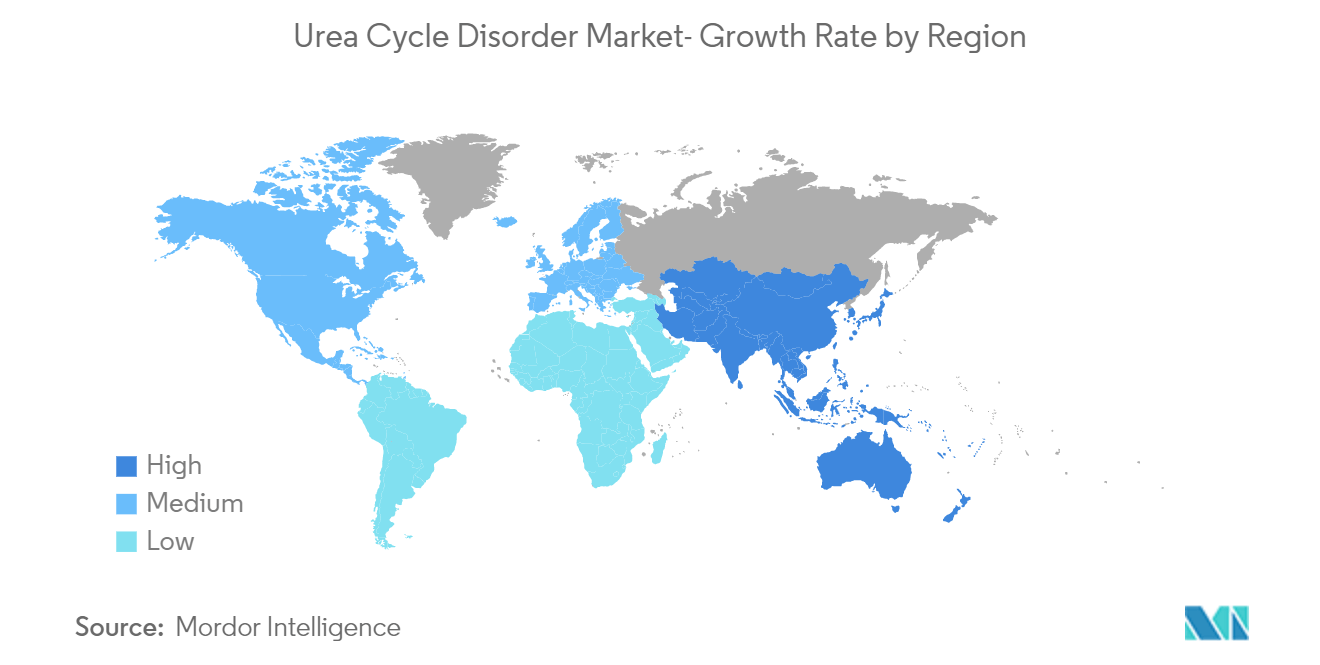
Competitive Landscape
The market is fragmented and moderately competitive. The strategies such as mergers and acquisitions adopted by major market players will boost the studied market growth. The major players in the market are Bausch Health Companies Inc., Recordati Rare Diseases, Eurocept Pharmaceuticals Holding (Lucane Pharma SA), Acer Therapeutics, Ultragenyx Pharmaceutical, and others.
Global Urea Cycle Disorder Industry Leaders
-
Bausch Health Companies Inc.
-
Recordati Rare Diseases
-
Eurocept Pharmaceuticals Holding (Lucane Pharma SA)
-
Acer Therapeutics
-
Ultragenyx Pharmaceutical
- *Disclaimer: Major Players sorted in no particular order
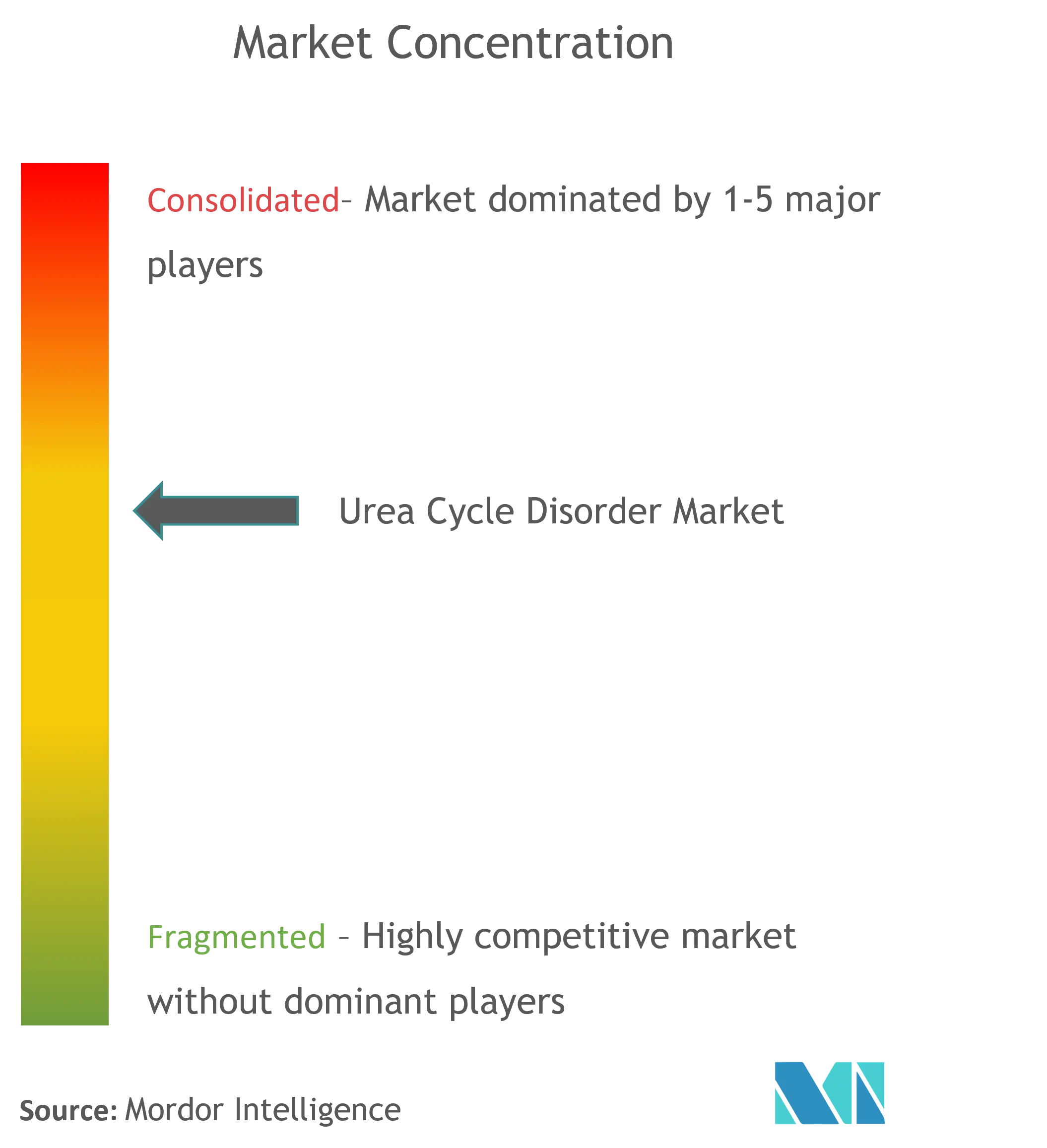
Recent Industry Developments
- In February 2022, Relief Therapeutics Holding SA and its collaboration partner, Acer Therapeutics, were issued a new patent from the United States Patent and Trademark Office (USPTO) for certain claims related to ACER-001 (sodium phenylbutyrate) related to ACER-001's multi-particulate dosage formulation for oral administration as a potential treatment for Urea Cycle Disorders (UCDs) and Maple Syrup Urine Disease (MSUD).
- In January 2022, Acer Therapeutics Inc. and Relief Therapeutics Holding SA announced the acceptance of four ACER-001 abstracts for poster presentations at the Society for Inherited Metabolic Disorders (SIMD) Annual Meeting on April 10-13, 2022, in Orlando, Florida, and the Genetic Metabolic Dieticians International (GMDI) Conference on May 4-7, 2022, in Las Vegas, Nevada.
Global Urea Cycle Disorder Market Report Scope
As per the scope of the report, urea cycle disorders are inborn errors of metabolism resulting from defects in one of the enzymes or transporter molecules involved in the hepatic removal of ammonia from the bloodstream. The Urea Cycle Disorder Market is Segmented by Treatment Type (Amino Acid Supplements, Sodium Phenylbutyrate, Glycerol Phenylbutyrate, Sodium Benzoate, and Others (Low Protein Diet, Carglumic Acid, etc.)), by Enzyme Deficiency Type (Ornithine Transcarbamylas (OTC), Argininosuccinate Synthetase (citrullinemia) (AS), Arginase (AG), Argininosuccinate Lyase (AL), Carbamoyl Phosphate Synthase (CPS1), and N-acetyl glutamate Synthase (NAGS)), by Route of Administration (Oral and Injectables), and by Geography (North America, Europe, Asia Pacific, and Rest of the World). The market report also covers the estimated market sizes and trends for 17 countries across major global regions. The report offers the value (in USD million) for the above segments.
| Amino Acid Supplements |
| Sodium Phenylbutyrate |
| Glycerol Phenylbutyrate |
| Sodium Benzoate |
| Others (Low Protein Diet, Carglumic Acid, etc.) |
| Ornithine Transcarbamylas (OTC) |
| Argininosuccinate Synthetase (citrullinemia) (AS) |
| Arginase (AG) |
| Argininosuccinate Lyase (AL) |
| Carbamoyl Phosphate Synthase (CPS1) |
| N-acetylglutamate Synthase (NAGS) |
| Oral |
| Injectable |
| North America | United States |
| Canada | |
| Mexico | |
| Europe | Germany |
| United Kingdom | |
| France | |
| Italy | |
| Spain | |
| Rest of Europe | |
| Asia-Pacific | China |
| Japan | |
| India | |
| Australia | |
| South Korea | |
| Rest of Asia-Pacific | |
| Rest of the World |
| By Treatment Type | Amino Acid Supplements | |
| Sodium Phenylbutyrate | ||
| Glycerol Phenylbutyrate | ||
| Sodium Benzoate | ||
| Others (Low Protein Diet, Carglumic Acid, etc.) | ||
| By Enzyme Deficiency Type | Ornithine Transcarbamylas (OTC) | |
| Argininosuccinate Synthetase (citrullinemia) (AS) | ||
| Arginase (AG) | ||
| Argininosuccinate Lyase (AL) | ||
| Carbamoyl Phosphate Synthase (CPS1) | ||
| N-acetylglutamate Synthase (NAGS) | ||
| By Route of Administration | Oral | |
| Injectable | ||
| Geography | North America | United States |
| Canada | ||
| Mexico | ||
| Europe | Germany | |
| United Kingdom | ||
| France | ||
| Italy | ||
| Spain | ||
| Rest of Europe | ||
| Asia-Pacific | China | |
| Japan | ||
| India | ||
| Australia | ||
| South Korea | ||
| Rest of Asia-Pacific | ||
| Rest of the World | ||
Key Questions Answered in the Report
What is the current Global Urea Cycle Disorder Market size?
The Global Urea Cycle Disorder Market is projected to register a CAGR of 3.4% during the forecast period (2025-2030)
Who are the key players in Global Urea Cycle Disorder Market?
Bausch Health Companies Inc., Recordati Rare Diseases, Eurocept Pharmaceuticals Holding (Lucane Pharma SA), Acer Therapeutics and Ultragenyx Pharmaceutical are the major companies operating in the Global Urea Cycle Disorder Market.
Which is the fastest growing region in Global Urea Cycle Disorder Market?
Asia-Pacific is estimated to grow at the highest CAGR over the forecast period (2025-2030).
Which region has the biggest share in Global Urea Cycle Disorder Market?
In 2025, the North America accounts for the largest market share in Global Urea Cycle Disorder Market.
What years does this Global Urea Cycle Disorder Market cover?
The report covers the Global Urea Cycle Disorder Market historical market size for years: 2019, 2020, 2021, 2022, 2023 and 2024. The report also forecasts the Global Urea Cycle Disorder Market size for years: 2025, 2026, 2027, 2028, 2029 and 2030.
Page last updated on:
Global Urea Cycle Disorder Market Report
Statistics for the 2025 Global Urea Cycle Disorder market share, size and revenue growth rate, created by Mordor Intelligence™ Industry Reports. Global Urea Cycle Disorder analysis includes a market forecast outlook for 2025 to 2030 and historical overview. Get a sample of this industry analysis as a free report PDF download.
